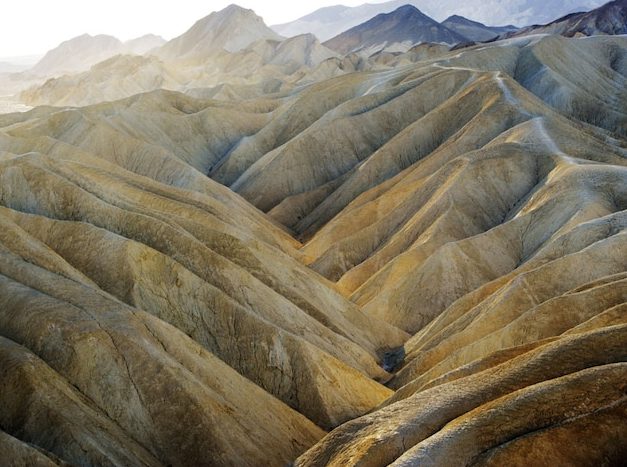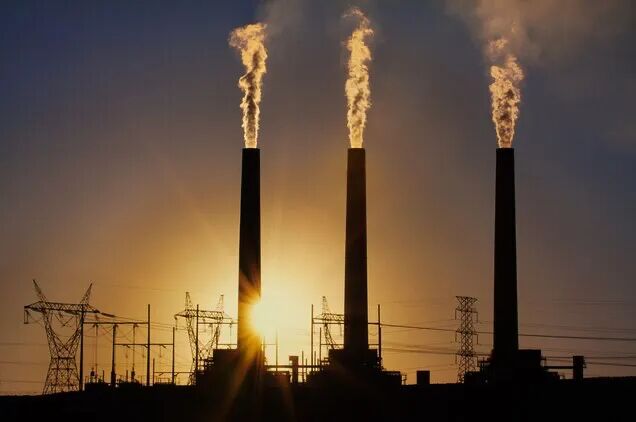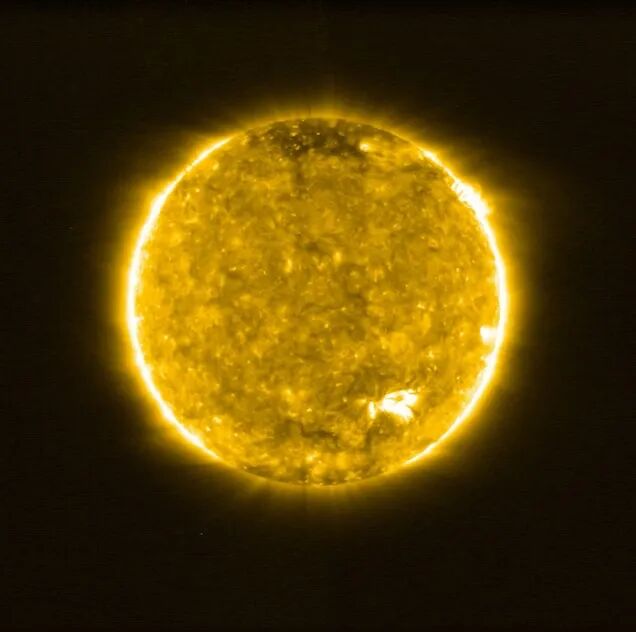
Me and My Earth
Environment | GlobalPlease set the National Geographic Chinese website as a bookmark to receive normal updates

The surface temperature of Venus is close to 482.22°C, and scientists speculate that millions of years ago it was similar to present-day Earth | NASA

Planetary scientists predict—the future fate of Earth is similar to that of Venus, where under a thick, toxic, sulfurous atmosphere, the surface temperature will approach about 482.22°C.This summer, a heatwave swept across the United States, with temperature records being repeatedly broken. Earlier this week, the global average temperature just exceeded 16.67°C. This is already the highest average temperature recorded since the National Centers for Environmental Prediction (NCEP) began recording temperatures in 1979.However, Earth has experienced even “hotter” periods in its history, and such conditions will recur in the future. This was a period known as the “hothouse”—when the atmosphere was filled with greenhouse gases, making the planet far hotter than it is now, with severe heatwaves leading to the most terrifying species extinctions.Currently, although human carbon emissions have not yet pushed Earth into a new “hothouse” phase, climate change proves that heatwaves are becoming increasingly severe.Venus has temperatures high enough to melt lead, serving as a contrast to Earth. Scientists say that while Earth will not suddenly become as unbearably hot and uninhabitable as Venus, high temperatures will continuously challenge human limits this century.And in the very distant future, Earth may indeed replicate the fate of Venus. Residents in Beijing during 40°C weather | CNN
Residents in Beijing during 40°C weather | CNN Earth’s Past “Extreme Heat Periods”Currently, it should not be the hottest time for Earth; according to geologists, Earth is currently in an “icehouse” period, which is cold enough to sustain a glacial cycle.During this period, large continental ice sheets should experience expansion near the poles, and currently, the continental ice sheets in the Northern Hemisphere have retreated north to Greenland.Although Earth’s temperature is already high enough, it is far from the limits known to humanity.
Earth’s Past “Extreme Heat Periods”Currently, it should not be the hottest time for Earth; according to geologists, Earth is currently in an “icehouse” period, which is cold enough to sustain a glacial cycle.During this period, large continental ice sheets should experience expansion near the poles, and currently, the continental ice sheets in the Northern Hemisphere have retreated north to Greenland.Although Earth’s temperature is already high enough, it is far from the limits known to humanity. The collapse of the Larsen B ice shelf in Antarctica in 2002 | National Geographic Atlas
The collapse of the Larsen B ice shelf in Antarctica in 2002 | National Geographic Atlas To glimpse what a hotter world might look like, one must look back 50 million years to the early Eocene.“That was the most recent extreme heat period in Earth’s history,” said Jessica Tierney, a paleoclimatologist at the University of Arizona.Today, the average temperature of Earth hovers around 15.56°C. The average temperature during the early Eocene was close to about 21.11°C, and the world then was entirely different from now: there was no ice at the poles; tropical oceans were on the verge of boiling at a steamy 35°C; palm trees grew in the Arctic, and crocodiles swam there.Going back a few million years further, during the Paleocene-Eocene Thermal Maximum (PETM), it was even hotter.The most extreme hothouse periods are hidden in the more distant geological past. During the Cretaceous Hot Greenhouse climate period 92 million years ago, global surface temperatures soared to about 29.44°C and remained at high temperatures for millions of years, leading to temperate rainforests flourishing near the South Pole. According to preliminary reconstruction models from the Smithsonian Institution, about 250 million years ago, during the transition from the Permian to the Triassic, a global “extreme heat event” maintained Earth’s average temperature at around 32.22°C for millions of years.That was a hellish period, during which species on Earth faced the most severe extinction in history. Tropical oceans seemed like a pot of hot water. Currently, humanity lacks climate data from the Permian or other ancient periods, but last week, the heatwave in California’s Death Valley (recorded highest surface temperature of 81.1°C) seemed to recreate the “extreme heat event.”“The hotter the general conditions, the more likely extreme heat events will occur,” Tierney said. “During the hottest days, desert regions will become incredibly hot.”
To glimpse what a hotter world might look like, one must look back 50 million years to the early Eocene.“That was the most recent extreme heat period in Earth’s history,” said Jessica Tierney, a paleoclimatologist at the University of Arizona.Today, the average temperature of Earth hovers around 15.56°C. The average temperature during the early Eocene was close to about 21.11°C, and the world then was entirely different from now: there was no ice at the poles; tropical oceans were on the verge of boiling at a steamy 35°C; palm trees grew in the Arctic, and crocodiles swam there.Going back a few million years further, during the Paleocene-Eocene Thermal Maximum (PETM), it was even hotter.The most extreme hothouse periods are hidden in the more distant geological past. During the Cretaceous Hot Greenhouse climate period 92 million years ago, global surface temperatures soared to about 29.44°C and remained at high temperatures for millions of years, leading to temperate rainforests flourishing near the South Pole. According to preliminary reconstruction models from the Smithsonian Institution, about 250 million years ago, during the transition from the Permian to the Triassic, a global “extreme heat event” maintained Earth’s average temperature at around 32.22°C for millions of years.That was a hellish period, during which species on Earth faced the most severe extinction in history. Tropical oceans seemed like a pot of hot water. Currently, humanity lacks climate data from the Permian or other ancient periods, but last week, the heatwave in California’s Death Valley (recorded highest surface temperature of 81.1°C) seemed to recreate the “extreme heat event.”“The hotter the general conditions, the more likely extreme heat events will occur,” Tierney said. “During the hottest days, desert regions will become incredibly hot.” Death Valley in California reached 81.1°C in July | National Geographic Atlas
Death Valley in California reached 81.1°C in July | National Geographic Atlas Carbon Dioxide is the CulpritEarth’s past several “hothouse” periods seem to have a common point: before they arrived, a large amount of greenhouse gases were released into the atmosphere, some of which were carbon dioxide from volcanic eruptions, and some were methane bubbling up from the seabed.Today, humanity is conducting a similar global “experiment”—burning vast amounts of fossil resources, increasing the concentration of carbon dioxide in the atmosphere at an unprecedented rate since the time of the dinosaur extinction 65 million years ago or even earlier.“When we see drastic changes in past climate history, we often find mechanisms behind them that are very similar to what humanity is doing today,” said Kristin Bergmann, a geoscientist at MIT. “Now, the changes in greenhouse gases causing Earth’s warming are happening quite rapidly.”Like in history, the global average temperature is once again rising rapidly, and extreme heat weather is also increasing. One study after another concludes that without human influence, the recent record-breaking high temperatures would have been unlikely to occur.
Carbon Dioxide is the CulpritEarth’s past several “hothouse” periods seem to have a common point: before they arrived, a large amount of greenhouse gases were released into the atmosphere, some of which were carbon dioxide from volcanic eruptions, and some were methane bubbling up from the seabed.Today, humanity is conducting a similar global “experiment”—burning vast amounts of fossil resources, increasing the concentration of carbon dioxide in the atmosphere at an unprecedented rate since the time of the dinosaur extinction 65 million years ago or even earlier.“When we see drastic changes in past climate history, we often find mechanisms behind them that are very similar to what humanity is doing today,” said Kristin Bergmann, a geoscientist at MIT. “Now, the changes in greenhouse gases causing Earth’s warming are happening quite rapidly.”Like in history, the global average temperature is once again rising rapidly, and extreme heat weather is also increasing. One study after another concludes that without human influence, the recent record-breaking high temperatures would have been unlikely to occur. |Photograph: FRANS LANTING, National Geographic Atlas
|Photograph: FRANS LANTING, National Geographic Atlas Experts say it is difficult to predict how hot Earth will become if humanity continues to “stuff” carbon dioxide into the atmosphere. Michael Wehner, an extreme weather researcher at the Lawrence Berkeley National Laboratory, wrote in an email: “How many degrees future heatwaves will rise largely depends on how much more carbon dioxide we will emit and for how long.”Wehner and his colleagues’ recent research shows us—what future heatwaves might look like if carbon emissions are completely unrestricted:By the end of this century, heatwaves in California are expected to continue to peak, potentially rising by about 5.55~7.77°C compared to today.Will We Replicate the Fate of Venus?For a long time, planetary scientists have predicted that as the sun continues to expand, Earth’s surface will continue to warm until the oceans begin to boil.Water vapor, as a potent greenhouse gas, will also pour into the atmosphere, triggering a runaway greenhouse effect, transforming our world to be indistinguishable from our “neighbor” Venus over a billion years.By then, under a thick, toxic, sulfurous atmosphere, the surface temperature will approach about 482.22°C.
Experts say it is difficult to predict how hot Earth will become if humanity continues to “stuff” carbon dioxide into the atmosphere. Michael Wehner, an extreme weather researcher at the Lawrence Berkeley National Laboratory, wrote in an email: “How many degrees future heatwaves will rise largely depends on how much more carbon dioxide we will emit and for how long.”Wehner and his colleagues’ recent research shows us—what future heatwaves might look like if carbon emissions are completely unrestricted:By the end of this century, heatwaves in California are expected to continue to peak, potentially rising by about 5.55~7.77°C compared to today.Will We Replicate the Fate of Venus?For a long time, planetary scientists have predicted that as the sun continues to expand, Earth’s surface will continue to warm until the oceans begin to boil.Water vapor, as a potent greenhouse gas, will also pour into the atmosphere, triggering a runaway greenhouse effect, transforming our world to be indistinguishable from our “neighbor” Venus over a billion years.By then, under a thick, toxic, sulfurous atmosphere, the surface temperature will approach about 482.22°C. The Solar Orbiter of the European Space Agency captured this image under extreme ultraviolet light. This wavelength of imaging helps reveal temperatures in the sun’s upper atmosphere reaching up to 1 million degrees | SOLAR ORBITER
The Solar Orbiter of the European Space Agency captured this image under extreme ultraviolet light. This wavelength of imaging helps reveal temperatures in the sun’s upper atmosphere reaching up to 1 million degrees | SOLAR ORBITER “This hypothetical scenario is similar to what Earth would encounter as the sun becomes more luminous,” said Paul Byrne, a planetary scientist at North Carolina State University. He added that billions of years ago, Venus may have also had a pleasant climate and oceans.It Won’t Be the Sun That Destroys Venus.Byrne said that according to recent modeling work, a series of episodic volcanic eruptions could cause“massive amounts of carbon dioxide to enter the atmosphere,” which may be the true culprit behind Venus’s demise.But whether it is the sun causing a planet to warm into a dead star, or massive volcanic eruptions, both scenarios point to the same trend: events far beyond human control could lead to Earth’s climate spiraling into uncontrollable high temperatures in the future. “I don’t know if it exactly reaches 475°C,” Byrne said when discussing the surface temperature of Venus. But if Earth is to transform into Venus, then the future will certainly be “very, very hot.”Even if our “blue planet” manages to avoid repeating Venus’s fate, it will still be hard to escape the end of being engulfed by the sun as it becomes a red giant in 5 billion years.
“This hypothetical scenario is similar to what Earth would encounter as the sun becomes more luminous,” said Paul Byrne, a planetary scientist at North Carolina State University. He added that billions of years ago, Venus may have also had a pleasant climate and oceans.It Won’t Be the Sun That Destroys Venus.Byrne said that according to recent modeling work, a series of episodic volcanic eruptions could cause“massive amounts of carbon dioxide to enter the atmosphere,” which may be the true culprit behind Venus’s demise.But whether it is the sun causing a planet to warm into a dead star, or massive volcanic eruptions, both scenarios point to the same trend: events far beyond human control could lead to Earth’s climate spiraling into uncontrollable high temperatures in the future. “I don’t know if it exactly reaches 475°C,” Byrne said when discussing the surface temperature of Venus. But if Earth is to transform into Venus, then the future will certainly be “very, very hot.”Even if our “blue planet” manages to avoid repeating Venus’s fate, it will still be hard to escape the end of being engulfed by the sun as it becomes a red giant in 5 billion years.
|NASA

Although it is far from us, this may be Earth’s destiny.Written by: MADELEINE STONETranslated by: Green Wine, ArvinEdited by: Arvin

Tap below 👇, thank you for your attention.Scan the QR code below to join the “National Geographic Selected Good Products Group”

Reach out your little hand

Like and “See” it